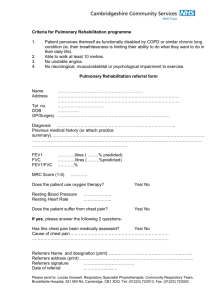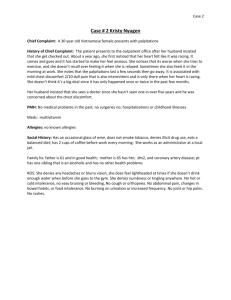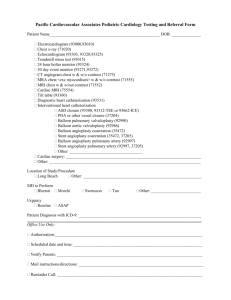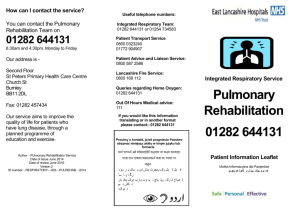CASE PREVIEW
advertisement
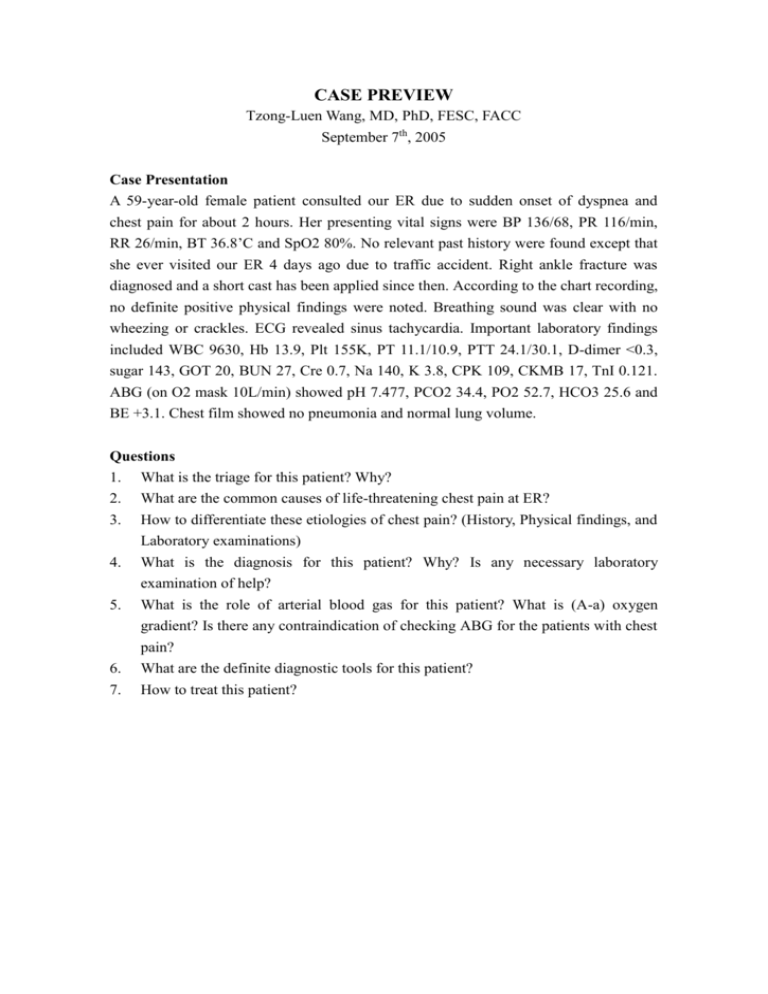
CASE PREVIEW Tzong-Luen Wang, MD, PhD, FESC, FACC September 7th, 2005 Case Presentation A 59-year-old female patient consulted our ER due to sudden onset of dyspnea and chest pain for about 2 hours. Her presenting vital signs were BP 136/68, PR 116/min, RR 26/min, BT 36.8’C and SpO2 80%. No relevant past history were found except that she ever visited our ER 4 days ago due to traffic accident. Right ankle fracture was diagnosed and a short cast has been applied since then. According to the chart recording, no definite positive physical findings were noted. Breathing sound was clear with no wheezing or crackles. ECG revealed sinus tachycardia. Important laboratory findings included WBC 9630, Hb 13.9, Plt 155K, PT 11.1/10.9, PTT 24.1/30.1, D-dimer <0.3, sugar 143, GOT 20, BUN 27, Cre 0.7, Na 140, K 3.8, CPK 109, CKMB 17, TnI 0.121. ABG (on O2 mask 10L/min) showed pH 7.477, PCO2 34.4, PO2 52.7, HCO3 25.6 and BE +3.1. Chest film showed no pneumonia and normal lung volume. Questions 1. What is the triage for this patient? Why? 2. What are the common causes of life-threatening chest pain at ER? 3. How to differentiate these etiologies of chest pain? (History, Physical findings, and 4. 5. 6. 7. Laboratory examinations) What is the diagnosis for this patient? Why? Is any necessary laboratory examination of help? What is the role of arterial blood gas for this patient? What is (A-a) oxygen gradient? Is there any contraindication of checking ABG for the patients with chest pain? What are the definite diagnostic tools for this patient? How to treat this patient? Question 1: What is the triage for this patient? Why? Considerations: 1. This patient should be triage 1 because of a. Possible life-threatening chest pain i. AMI Vf , PEA (EMD) sudden death ii. Aortic dissection Rupture, MOF sudden death iii. Cardiac tamponade PEA (sudden death) iv. Tension pneumothorax PEA (sudden death) v. Esophageal rupture (Boerhaave syndrome) severe metabolic acidosis, respiratory failure, shock death vi. Pulmonary embolism hypoxia, sudden death (PEA) b. Respiratory distress (D/D: dyspnea; tachypnea; orthopnea; platypnea) with hypoxemia c. Tachycardia suggesting unexplained stress Question 2: What are the common causes of life-threatening chest pain at ER? Considerations: 1. Acute coronary syndrome 2. 3. 4. 5. 6. a. ST elevated myocardial infarction (STEMI) b. Non-ST elevated myocardial infarction (NSTEMI) c. Unstable angina Dissecting aortic aneurysm Pulmonary embolism Tension pneumothorax Cardiac tamponade Esopheageal rupture Question 3: How to differentiate these etiologies of chest pain? (History, Physical findings, and Laboratory examinations) Considerations: Myocardial Ischaemic Pain The main feature of myocardial ischaemia (impending infarction) is usually prolonged chest pain. Typical characteristics of the pain include: Duration usually over 20 minutes Located in the retrosternal area, possibly radiating to the arms (usually to the left arm), back, neck, or the lower jaw The pain is described as pressing or heavy or as a sensation of a tight band around the chest; breathing or changing posture does not notably influence the severity of the pain. The pain is continuous, and its intensity does not alter The symptoms (pain beginning in the upper abdomen, nausea) may resemble the symptoms of acute abdomen. Nausea and vomiting are sometimes the main symptoms, especially in inferoposterior wall ischaemia. In inferoposterior wall ischaemia, vagal reflexes may cause bradycardia and hypotension, presenting as dizziness or fainting. Electrocardiogram (ECG) is the key examination during the first 4 hours after pain onset, but normal ECG does not rule out an imminent infarction. Markers of myocardial injury (cardiac troponins T and I, creatine kinase-MB mass) start to rise about 4 hours after pain onset. An increase of these markers is diagnostic of myocardial infarction irrespective of ECG findings. Minor signs of myocardial infarction in ECG Risk factors: Hypertension; DM; Hyperlipidemia; Smoking; Family history; CAD history; Homocysteinemia; Hyperuricemia Nonischaemic Causes of Chest Pain Illness/condition Reflux oesophagitis, oesophageal spasm Differentiating symptoms and signs Pulmonary embolism Hyperventilation No ECG changes Heartburn Worse in recumbent position, but also while straining, like angina pectoris The most common cause of chest pain Tachypnoea, hypoxaemia, hypocarbia No pulmonary congestion on chest x-ray Clinical presentation may resemble hyperventilation. Both arterial oxygen pressure (PaO2) and partial arterial pressure of carbon dioxide (PaCO2) decreased. Pain is not often marked. D-dimer assay positive Hyperventilation Syndrome The main symptom is dyspnoea, as in pulmonary embolism. Often a young patient Illness/condition Differentiating symptoms and signs Tingling and numbness of the limbs, dizziness PaCO2 decreased, PaO2 increased or normal Secondary Hyperventilation Attributable to an organic illness/cause; acidosis, pulmonary embolism, pneumothorax, asthma, infarction, etc. Spontaneous pneumothorax Dyspnoea is the main symptom. Auscultation and chest x-ray Aortic dissection Severe pain with changing localization Type A dissection sometimes obstructs the origin of a coronary artery (usually the right) with signs of impending inferoposterior infarction Pulses may be asymmetrical Pericarditis Change of posture and breathing influence the pain. A friction sound may be heard. ST-elevation but no reciprocal ST depression A stabbing pain when breathing. The most common Pleuritis Sometimes broad mediastinum on chest x-ray New aortic valve regurgitation cause of stabbing pain is, however, caused by prolonged cough Costochondral pain Early herpes zoster Ectopic beats Peptic ulcer, No ECG changes, rash Localized paraesthesia before rash Transient, in the area of the apex Clinical examination (inferior wall ischaemia may cholecystitis, pancreatitis Depression resemble acute abdomen) Alcohol-related Palpation tenderness, movements of chest influence the pain Might also be an insignificant incidental finding Continuous feeling of heaviness in the chest, no correlation to exercise ECG normal A young male patient in a casualty department, inebriated Question 4: What is the diagnosis for this patient? Why? Is any necessary laboratory examination of help? Considerations: 1. Pulmonary Embolism 2. Suggestive a. Tachypnoea and dyspnea, sudden onset b. Hypoxaemia c. hypocarbia d. No pulmonary congestion on chest x-ray e. Pain is not often marked. o o o o o o o o o o 96% have tachypnea (respiratory rate >16/min) 58% develop rales 53% have an accentuated second heart sound 44% have tachycardia (heart rate >100/min) 43% have fever (temperature >37.8° C) 36% have diaphoresis 34% have an S3 or S4 gallop 32% have clinical signs and symptoms suggesting thrombophlebitis 24% have lower extremity edema 23% have a cardiac murmur o f. 19% have cyanosis Risk factors: bedridden; casting (fracture); DVT; hypercoagubility; tumor o AIDS (lupus anticoagulant) o Antithrombin III deficiency o Behcet disease o Blood type A o Burns o Catheters (indwelling venous infusion catheters) o Chemotherapy o o o o o o o o o Congestive heart failure (CHF) Drug abuse (intravenous [IV] drugs) Drug-induced lupus anticoagulant DVT in the past Estrogen replacements (high dose only) Fibrinogen abnormality Fractures Hemolytic anemias Heparin-associated thrombocytopenia o Homocystinuria o Hyperlipidemias Immobilization Malignancy Myocardial infarction Obesity Old age Oral contraceptives PE in the past Phenothiazines Plasminogen abnormality o o o o o o o o o o o o o o o o o o o o o o o o o o Plasminogen activator abnormality Polycythemia Postoperative Postpartum period Pregnancy Protein C deficiency Protein S deficiency Resistance to activated protein C Systemic lupus erythematosus Thrombocytosis Trauma Ulcerative colitis Varicose veins Venography Venous pacemakers Venous stasis Warfarin (first few days of therapy) 3. Laboratory a. Both arterial oxygen pressure (PaO2) and partial arterial pressure of carbon b. c. d. e. dioxide (PaCO2) decreased. D-dimer assay positive (This patient is D-dimer negative). Spiral CT Perfusion scan: ventilation/perfusion mismatch Angiography Question 5 and 6: What is the role of arterial blood gas for this patient? What is (A-a) oxygen gradient? Is there any contraindication of checking ABG for the patients with chest pain? What are the definite diagnostic tools for this patient? Comments: 1. ABG may be of help in diagnosis of pulmonary embolism, especially by calculating (A – a) oxygen pressure gradient 2. (A – a) oxygen pressure gradient (A – a) oxygen pressure gradient = (760 – vapor pressure) x FiO2 – PaCO2/0.8 – PaO2 3. The initial chest x-ray (CXR) findings of a patient with PE are virtually always normal. o the Westermark sign(rare): a dilatation of the pulmonary vessels proximal to an embolism along with collapse of distal vessels, sometimes with a sharp cutoff. o Atelectasis and an elevated hemidiaphragm. o After 24-72 hours, one third of patients with proven PE develop focal infiltrates that are indistinguishable from an infectious pneumonia. o A rare late finding of pulmonary infarction is the Hampton hump, a triangular or rounded pleural-based infiltrate with the apex pointed toward the hilum, frequently located adjacent to the diaphragm. Nuclear scintigraphic ventilation-perfusion (V/Q) scanning of the lung is the single most important diagnostic modality for detecting pulmonary thromboembolism available to the clinician. o V/Q scan is indicated whenever the diagnosis of PE is suspected and no alternative diagnosis can be proved. V/Q also is indicated for most patients with DVT even without symptoms of PE. o A repeat V/Q scan is indicated before stopping anticoagulation in a patient with irreversible risk factors for DVT and PE, because recurrent symptoms are common and a reference “posttreatment” V/Q scan can serve as a new baseline for comparison, often sparing the patient the need for a future angiogram. o Diagnostic V/Q patterns classified as high probability or as normal perfusion may be relied upon to guide the clinical management of patients when the prior clinical assessment is concordant with the scan result. Normal V/Q scan o No perfusion defects are seen. o At least 2% of patients with PE have this pattern, and 4% of patients with this pattern have PE. This means that approximately 1 of every 25 patients sent home after a normal V/Q scan actually has a PE that has been missed. This is unfortunate, but risk-benefit analysis supports the idea that unless the presentation is highly convincing and no alternate diagnosis is demonstrable, a normal perfusion scan pattern often may be considered negative for PE. High-probability scan o This includes scans with any of the following findings: Two or more segmental or larger perfusion defects with normal CXR and normal ventilation o o Two or more segmental or larger perfusion defects where CXR abnormalities and ventilation defects are substantially smaller than the perfusion defects Two or more subsegmental and one segmental perfusion defect with normal CXR and normal ventilation Four or more subsegmental perfusion defects with normal CXR and normal ventilation Forty-one percent of patients with PE have this pattern and 87% of patients with this pattern have PE. In most clinical settings, a high-probability scan pattern may be considered positive for PE. Nondiagnostic scan (with a pattern type that was formerly graded as low probability) o This includes scans with any of the following findings: Small perfusion defects, regardless of number, ventilation findings, or CXR findings Perfusion defects substantially smaller than a CXR abnormality in the same area Matching perfusion and ventilation defects in less than 75% of o one lung zone or in less than 50% of one lung, with a normal or nearly normal CXR A single segmental perfusion defect with a normal CXR, regardless of ventilation match or mismatch Nonsegmental perfusion defects Sixteen percent of patients with PE have this pattern and 14% of patients with this pattern have PE. This pattern often is called "low probability," but the term is a misnomer: in a typical population, 1 in 7 patients with this pattern turn out to have a PE. o This scan pattern is an indication for pulmonary angiography or some other definitive test. All patients suspected of PE who have a nondiagnostic scan must have PE definitively ruled out or some definitive alternative diagnosis made. Discharging such patients without a definitive diagnostic outcome is highly inappropriate, as this leads to the deaths of many patients. Nondiagnostic scan (with a pattern type that was formerly graded as "intermediate probability") o Any V/Q abnormality not otherwise classified: Approximately 40% of patients with PE fall into this category and 30% of all patients with this pattern have PE. o This scan pattern is always an indication for pulmonary angiography or another definitive test to rule out PE. Failure to pursue the diagnosis further in these patients leads to disastrous outcomes. 4. Pulmonary angiography remains the criterion standard for the diagnosis of PE. When performed carefully and completely, a positive pulmonary angiogram provides virtually 100% certainty that an obstruction to pulmonary arterial blood flow does exist. A negative pulmonary angiogram provides greater than 90% certainty in the exclusion of PE. A positive angiogram is an acceptable endpoint no matter how abbreviated the study. However, a complete negative study requires the visualization of the entire pulmonary tree bilaterally. This is accomplished via selective cannulation of each branch of the pulmonary artery and injection of contrast material into each branch, with multiple views of each area. Even then, emboli in vessels smaller than third order or lobular arteries are not seen. Small emboli cannot be seen angiographically, yet embolic obstruction of these smaller pulmonary vessels is very common when postmortem examination follows a negative angiogram. These small emboli can produce pleuritic chest pain and a small sterile effusion even though the patient has a normal V/Q scan and a normal pulmonary angiogram. In most patients, however, PE is a disease of multiple recurrences, with both large and small emboli already present by the time the diagnosis is first suspected. Under these circumstances, both the V/Q scan and the angiogram are likely to detect at least some of the emboli. 5. High-resolution helical (spiral) computed tomographic angiography (CTA) is a promising technique that soon may replace ordinary contrast pulmonary angiography. In many patients, helical CT scans with intravenous contrast can resolve third-order pulmonary vessels without the need for invasive pulmonary artery catheters. o The absolute sensitivity and specificity of CTA are evolving over time. Today we can say safely that in a patient with hemodynamic collapse due to a large PE, CTA is unlikely to miss the lesion. In a patient with pleuritic chest pain due to multiple small emboli that have lodged in distal vessels, CTA is more likely to miss the lesions, but these lesions also may be difficult to detect using conventional angiography. o Ongoing studies will determine whether the sensitivity and specificity of CTA are high enough to displace invasive angiography for the diagnosis of PE. 6. Duplex ultrasound A negative ultrasound scan does not rule out DVT, because many DVTs occur in areas that are inaccessible to ultrasonic examination. Before an ultrasound scan can be considered negative, the entire deep venous system must be interrogated using centimeter-by-centimeter compression testing of every vessel. o In two thirds of patients with PE, the site of DVT cannot be visualized by ultrasound, so a negative duplex ultrasound does not markedly reduce the likelihood of PE. Other Tests: Electrocardiogram o The most common ECG abnormalities in the setting of PE are tachycardia and nonspecific ST-T wave abnormalities. o Any other ECG abnormality may appear with equal likelihood, but none are sensitive or specific for PE. o The classic findings of right heart strain and acute cor pulmonale are tall, peaked P waves in lead II (P pulmonale), right axis deviation, right bundle-branch block, an S1-Q3-T3 pattern, or atrial fibrillation. o o Unfortunately, only 20% of patients with proven PE have any of these classic ECG abnormalities. If ECG abnormalities are present, they may be suggestive of PE, but the absence of ECG abnormalities has no significant predictive value. One fourth of patients with proven PE have ECGs that are unchanged from their baseline state. Question 7: How to treat this patient? Comments: Fibrinolytic therapy: Unless overwhelming contraindications are evident, a rapidly acting fibrinolytic agent should be administered immediately to every patient who has suffered any degree of hypotension or is significantly hypoxemic from PE. o Improvement of hypotension in response to hydration or pressors does not remove the indication for immediate fibrinolysis. The fact that hypotension has occurred at all is a sufficient indication that the patient has exhausted his or her cardiopulmonary reserves and is at high risk for sudden collapse and death. o Fibrinolysis also is strongly indicated for patients with PE who have any evidence of right heart strain, because substantial evidence indicates that the mortality rate can be cut in half by early fibrinolysis in this patient population. Heparin reduces the mortality rate of PE because it slows or prevents clot progression and reduces the risk of further embolism. o Heparin does nothing to dissolve clot that has developed already, but it is still the single most important treatment that can be provided, because the greatest contribution to the mortality rate is the ongoing embolization of new thrombi. Prompt effective anticoagulation has been shown to reduce the overall mortality rate from 30% to less than 10%. o Early heparin anticoagulation is so essential that heparin should be started as soon as the diagnosis of pulmonary thromboembolism is considered seriously. Anticoagulation should not wait for the results of diagnostic tests: if anticoagulation is delayed, venous thrombosis and PE may progress rapidly. Oxygen should be administered to every patient with suspected PE, even when the arterial PO2 is perfectly normal, because increased alveolar oxygen may help to promote pulmonary vascular dilatation. IV fluids may help or may hurt the patient who is hypotensive from PE depending on which point on the Starling curve describes the patient's condition. o A Swan-Ganz catheter is helpful to determine whether a fluid bolus is indicated; as an alternative, a cautious trial of a small fluid bolus may be attempted, with careful surveillance of the systolic and diastolic blood pressures and immediate cessation if the situation worsens after the fluid bolus. o Improvement or normalization of blood pressure after fluid loading does not mean the patient has become hemodynamically stable. o Fibrinolysis is indicated overwhelmingly for any patient with a PE large enough to cause hypotension, even if the hypotension is transient or correctable. As noted above, early fibrinolysis is expected to reduce the mortality rate by 50% for patients who have right ventricular dysfunction due to PE, even if they are hemodynamically stable. Cardiopulmonary resuscitation (CPR) and advanced cardiac life support (ACLS) protocols are of no value in patients whose cardiac arrest is due to PE, since obstruction of the pulmonary circuit prevents oxygenated blood from reaching the peripheral and cerebral circulation. o The only management approaches likely to be helpful in this situation are emergency cardiopulmonary bypass or emergency thoracotomy. o If cardiopulmonary bypass with extracorporeal membrane oxygenation is available, it may be lifesaving for patients with massive PE in whom cardiac arrest has occurred or appears imminent. Prior to the introduction of emergency cardiopulmonary bypass, the expected mortality rate after cardiac arrest from PE was 100%. Although experience with the technique is limited, one study reported the complete recovery of 7 of 9 patients when cardiopulmonary bypass was used to stabilize the patients for operative embolectomy. If emergency cardiopulmonary bypass is not available, several case reports suggest that immediate bilateral thoracotomy and massage of the pulmonary vessels may dislodge a saddle embolus and restore circulation to part of the pulmonary vascular tree. o This aggressive procedure is appropriate in patients with cardiac arrest from proven or highly likely PE, because the expected mortality rate without the procedure is 100%. o The procedure is not one to be used as a "last resort." Thoracotomy must be carried out immediately to be of any value, because in cardiac arrest from PE, closed-chest CPR is not able to provide any blood flow to the cerebral circulation. Compression stockings



